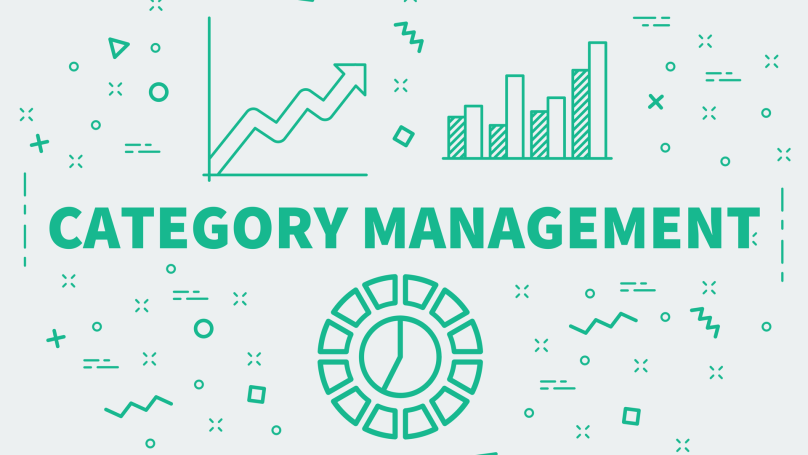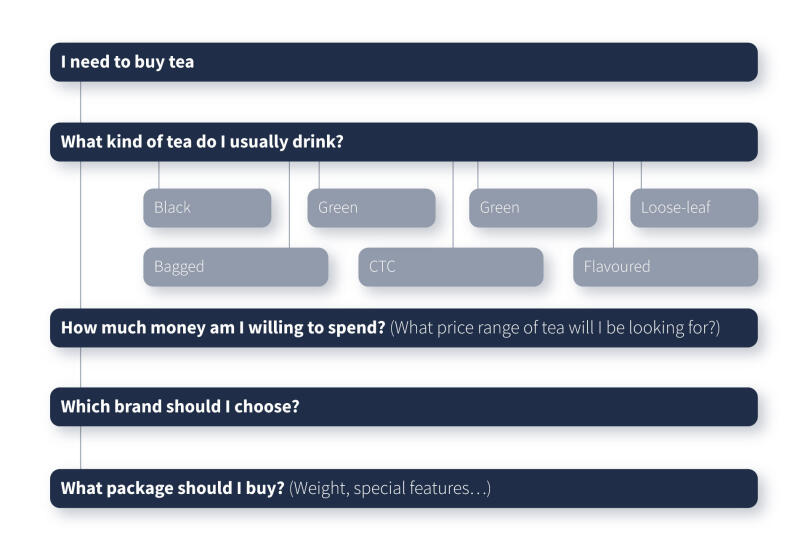Category management
What is category management?

Category management is the management of the assortment in retail, where you divide the assortment into groups (categories) with common characteristics or objectives. For example, you arrange the shelves of a shop according to the principle of category management: one shelf has only dairy products, another has meat products, etc. The key indicator of category management is the increase in sales of goods in a particular category and the profitability of its sales.
Thus, the role of category management is to streamline the retail space, making it more convenient and efficient for both the company and the customer. Additionally, the goal of category management is to increase profits and sales.
The advantages and disadvantages of category management
The advantages of category management can be listed as follows:
- it increases customer satisfaction with the shop due to the convenience and visualised variety of the assortment;
- it increases the average bill, customer loyalty and the total number of sales;
- it makes it easier to deal with business contacts and suppliers;
- it minimises the amount of illiquid inventory;
- it creates a positive image of the company.
Despite the positive features of category management functions, it also has disadvantages. Here are two of the main ones:
- The staffing issue. A special person, the category manager, is responsible for implementing category management. Therefore, they must have the necessary knowledge, namely experience in marketing, an understanding of product management, analytical skills and knowledge of finance.
- The assortment and inventory management process in the supply chain. If the number of items and business contacts grows, so does the number of objects of analysis and the supply chain itself. That is why category management is unsuitable for developed shop chains with multi-format retailing.
Category management in procurement

Most often, retail is where the concept of category management is applied. It involves the management of procurement and makes it possible to buy the right products with maximum profit, save money and establish a more stable partnership. Therefore, category management in procurement involves a strategic, careful and incremental approach to buying activities to maximise the effectiveness of a company and its trade.
The practice of category management
The practice of category management first emerged in the early 1990s. Hygiene products corporation Procter & Gamble spawned the term to simplify the management of sales units by grouping them into flexible and structured categories. Since it is easier to analyse product categories than product items, the approach quickly gained traction in retail. However, the founder of management, who developed the theoretical foundations of category management, is Professor Brian F. Harris of the University of Southern California. He also came up with the category management methodology, which is still used and adopted by various companies today.
Category management tools
Category management can use any marketing tools that allow the retailer and company owner to get a thorough understanding of customers' needs, their opinions on the assortment, suppliers, and the benefits of the products themselves. Even basic arithmetic comes in handy here, but the most commonly used category management tools are:
- SWOT (Strength, Weakness, Opportunity, and Threat) analysis is a method of strategic planning that identifies the strengths and weaknesses of the company, the formed category, specific products and even the buyer.
- PEST (Political, Economic, Social, and Technological) analysis is a strategic tool for analysing the external environment and identifying threats and industry trends.
- Retrospective is a method of improving current business processes by analysing and discussing their past performance (used to evaluate suppliers).
- A/B testing is used to evaluate the effectiveness of a category, category plan, category promotion, etc.
- Conducting a survey or questionnaire is a way of studying customer needs to determine strategy, tactics or categories.
- Decision tree (see the section below).
Components of category management

The structure of category management has three main components:
- The philosophy description - these are the business management strategies that the vendor and the supplier build. These strategies shape and organise the business units and individual business processes, ensuring effective planning to achieve sales and profits.
- The process description - the vendor and supplier jointly develop category plans based on the analysis and results of the previous period and define strategic and financial objectives for the categories to achieve.
- The organisational concept is a procurement plan and a plan to implement ideas in logistics, promotion, and sales.
Roles of categories in category management
A category's role is the purpose for which a particular group of goods for retailing is formed. In simple terms, it is the role that determines how products are perceived by consumers and allows products to be systematically grouped into a single category. The key roles of categories in category management are as follows:
- Target or unique category refers to products that customers come for specifically. These products are the most important for a company because they play a key role in generating turnover and profit. For example, books would be the target category for a bookstore, and cuddly toys and backpacks would not be included in it.
- Basic or main category includes goods that are important to the customer but are not considered a priority. While important for turnover benefit and competitiveness, this category is not that useful for the customer. In the case of a bookstore, this would include, for example, stationery.
- Seasonal category is about goods that are important and sold at a certain period, coinciding with a certain season or a holiday. They also have priority over other interests for this period. For example, a bookstore may sell artificial decorative pumpkins for Halloween.
- Related category is for secondary goods that are not important to either the customer or the chain, but having them in the shop's range can save the customer time and satisfy their secondary needs. These products are often "status goods" and affect brand image and recognition - for instance, branded tote bags or collectable figurines.
Category management strategies

You can identify the following category management strategies and activities:
- Forming an optimal assortment and creating a competent assortment policy . This strategy aims to develop all company product groups through clear positioning. Its objective is to bring the categories in line with customer needs and the company brand so that the categories generate the intended revenue. You achieve this by using questionnaires and surveys' marketing and customer feedback insights.
- Promotion management. This strategy aims to create a chain of marketing activities necessary to promote product categories based on the tools of trade marketing and BTL. Moreover, the use of category management analytics also helps to stimulate sales.
- The right product presentation. A trade policy is formed by studying customer preferences and needs that ensure the effective launch of product categories. This strategy also makes it possible to respond quickly to changes in demand and adjust plans or the categories themselves to include in the range those products that offer the greatest value to customers.
The decision tree in category management
The decision tree in category management is a schematic (visualised) representation of the customer's decision making process during a shopping trip. It is essentially a visual representation of the customer's decision-making process, from when they enter the shop to paying for a product. The depiction of the decision tree is one of the best analytical tools to gain unexpected insights into strategy development and to generate hypotheses that can contribute to the development of the entire retail chain.
The decision tree allows you to:
- Simplify the buyer's journey by grouping products in the way they normally look for them.
- Increase demand for certain categories and understand which products may be worth discarding. Or, indeed, how to incorporate them into the customer journey).
- Discover how products compete with each other and which ones win.
- Identify the boundaries of the categories and narrow them down or expand them if necessary.
- Understand the customers' needs motivating them to move in a certain direction.
Here is what a decision tree might look like in practice:

Stages of transition to category management

The main stages in the transition to category management are as follows:
Stage 1. Analysis and synthesis
An assortment of goods is monitored to determine what is purchased and in what quantities, how often it is purchased, the budget, and who the main partner (supplier) is. That will highlight the main product categories based on materials and suppliers, which will help in the future.
Stage 2. Research
The company conducts research into the supplier and B2B market to select the most profitable and effective partners. A clear list should be drawn up, including supplier contracts, terms, costs and other conditions with comments and observations from experience (if there are any).
Stage 3. Strategy development
It formulates an action plan to optimise business processes and product mix. At this stage, the company develops a procurement strategy and identifies the best methods, requirements, and action algorithms. You can create separate scripts for talking to suppliers and work through the most popular objections in them.
Stage 4. Establishing partnerships
Assess all risks and requirements to implement category management safely, which is largely dependent on suppliers. Therefore, it is necessary to agree with the partner on the most favourable terms and record the volume of goods and all agreements.
Stage 5. Evaluation of results
The qualitative performance indicators are defined, and basic criteria are approved, against which future performance is measured. The supplier relationships will be evaluated, along with the current procurement management strategy, the assortment set up, etc. You can do this by brainstorming with the team or hiring a separate specialist (category manager).
Eight steps of category management

Once the transition to category management has been successfully completed, you can implement it directly. The steps of category management are as follows:
- Category definition . At this point, the seller sorts the products into groups according to their purpose, characteristics, popularity with consumers, availability of packaging, or any other criteria. Here the question may arise on exactly what criteria to use to form categories - you should be guided strictly by the goals and type of your business, your preferences and available resources.
- The role of the category. The seller then determines the level of importance of each group, thereby prioritising the categories by comparing the categories to the needs of buyers. The more in-demand and important the products are for the buyer, the higher their role. This information is also often used to develop a basis for further resource allocation across the business.
- Category evaluation. The seller conducts a category-specific analysis, considering the number of sales of the products within the category, overall profitability, economic profitability, and supplier information. The evaluation will require various analysis methods capable of competently evaluating the strengths and weaknesses of each category and its prospects.
- Defining the effectiveness of the category. The vendor develops specific requirements and criteria for evaluating category performance. Indicators that are both numerically and qualitatively measurable must be identified. For example, the number of sales, volume of purchases, margins, and cost recovery ratio (GMROI) are often taken into account.
- Developing a strategy for each category. The vendor establishes goals for each category and optimises business processes to contribute to their maximum realisation. The main objective of strategy development is to plan resources wisely for the effective promotion and sale of product categories.
- Developing category tactics. In this step, the retailer clearly defines the category assortment and establishes prices and shelf space of products (which is also crucial for the correct implementation of the strategy). Additionally, the tactic defines specific actions needed to achieve the objectives of the category strategies.
- Category Implementation. The retailer implements the category business plan by systematically following a schedule and list of responsibilities. As a result, the plan's implementation occurs under the previously set objectives without any changes or urgent adjustments, which is important for category management.
- Category revision. At this stage, the vendor, in conjunction with the supplier, reviews the category and evaluates the effectiveness and efficiency of the implemented business plan. They develop and adopt an alternative strategy if any new opportunities or threats to the category are identified. Again, this helps the company select only the best practices.
A course and relevant training will help you to master category management. Additionally, you can find textbooks in the public domain today - for example, John O'Brien's book "Category Management in Procurement: A Strategic Approach," which sets out all the theory and practice of this type of management.
Examples of category management

An example of categories in an e-commerce fashion shop might look like this:
- Clothing: t-shirts, shirts, shorts, dresses, jeans;
- Accessories: bags, backpacks, jewellery, hats;
- Footwear: boots, trainers, shoes;
- Luxury collection: luxury brands;
- Seasonal wear: coats, hats, mittens, umbrellas.
Category management features also mean that a category can have its subcategory (which can be analysed separately from other subcategories or combined with them). It is done primarily to improve the customer experience. Such space organisation makes it easier to navigate through the shops, search for specific products, and make the choice easier.
Also, for example, you can use category management in pharmaceutical (chemist) products or any other industry to increase sales of certain (not very successful) products. For example, suppose that one category contains Brand A and Brand B. When Brand A heavily promotes its products on TV, its products in the shop sell out faster than Brand B, and the seller suffers first and foremost because they get left with unsold goods. So, if you want to implement category management, you need to know how to compensate for the lack of promotion of brand B locally so that both brands sell out equally. For example, by building a decision tree and collecting customer information, the retailer can assign Brand A a separate category or place it alongside a similarly successful brand and assign B a smaller category, but with more promotion within the shop.























